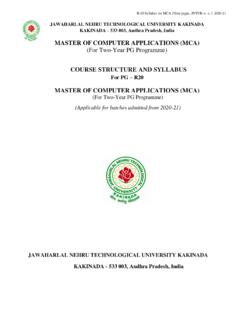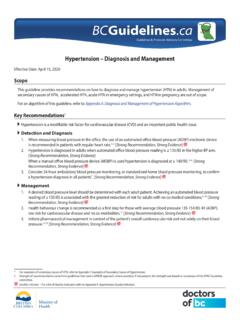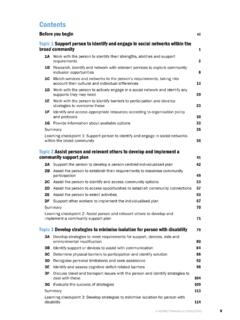Transcription of Biological sample collection, processing, storage
1 Unit 2 Chapter 3. Biological sample collection, processing, storage , and information management23 UNIT 2 CHAPTER 3unit : practical aspectschapter 3. Biological sample collection, processing, storage and information managementJimmie B. Vaught and Marianne K. HendersonSummaryThe collection, processing and storage of Biological samples occur in the larger context of organizations known as Biological resource centres or biospecimen resources. Biological resource centres are (1,2) service providers and repositories of living cells, as well as genomes of organisms, archived cells and tissues, and information relating to these materials. The US National Cancer Institute (3) defines a biospecimen resource as a ..collection of human specimens and associated data for research purposes, the physical entity where the collection is stored, and all relevant processes and policies.
2 The complexities involved in proper sample management policies and procedures are often underestimated. Prior to initiating a study that will involve the collection of Biological samples, many decisions need to be made that will affect the quality of the samples and the outcome of the study. The appropriate sample type(s) needs to be chosen. The processing protocol that will result in samples of suitable quality for the intended laboratory analyses must be selected from among various possible protocols. Consideration must be given to the proper storage conditions to maintain sample quality until analyses are completed. All of these activities must be monitored and controlled by appropriate sample tracking and laboratory informatics systems.
3 A comprehensive quality management system, with standard operating procedures and other appropriate controls, is necessary to assure that Biological samples are of consistent quality and right for the intended analyses and study Biological specimens have been collected for use in a variety of molecular epidemiology, clinical trial and basic research studies for many years, it has only recently been recognized that the protocols and practices involved in collecting, processing and storing specimens actually comprise biospecimen science. As a result, many organizations (Appendix ) have engaged in producing guidelines and best practices for these endeavours, now known as Biological resource centres or biospecimen resources.
4 24 Appendix Existing guidelines and best practices for biorepositoriesTitleAuthors/OriginRefere nce/LinkTissue Banking for Biomedical ResearchNational Cancer Centre/ ProtocolsAustralian Biospecimen Network, ABN/ Resource Centres: Underpinning the Future of Life Sciences and BiotechnologyOECD/ Human Frozen Tumor Tissue Bank TUBAFROSTTUBAFROST/The Tissue and Biological Samples for use in Research: Operational and Ethical GuidelinesMRC/ Practices for Repositories I: Collection, storage , and Retrieval of Human Biological Materials for ResearchInternational Society for Biological & Environmental Repositories/USACell Preserv Technol 2008;6:3-58 First-Generation Guidelines for NCI-Supported Biospecimen ResourcesNCI/ Recommendations on the Transport of Dangerous Goods. Model RegulationsUN Economic Commission for Europe, UNECE/ Collection, Preparation, and HandlingLabCorp/ organizations have published guidelines and best practices relevant to the discussion in this chapter (54).
5 This table is adapted from the IARC publication International Network of Biological Resource Centres for Cancer Research: Recommendations on Common Minimal Technical Standards (2). Unit 2 Chapter 3. Biological sample collection, processing, storage , and information management25 UNIT 2 CHAPTER 3 These terms reflect the fact that specimen management takes place in an environment that includes a wide range of policies concerning the specimens and data, as well as the physical structure, the biorepository. Biological resource centres are engaged in many activities beyond storage , such as acquiring, processing ( aliquoting, DNA extraction) and distributing Biological materials. The practices and policies that have been organized into formal documents testify to the importance of following proper steps that will result in the highest quality specimens for research purposes.
6 The use of proper procedures to produce Biological specimens of the appropriate quality, as well as the collection of relevant clinical, epidemiologic and quality control data, gives the biospecimens their value in and public health significanceBiological specimens (or biospecimens), such as blood, urine, saliva, and many other types, are collected for a variety of reasons, for normal patient monitoring and care as well as for basic, clinical and epidemiologic research studies. Many medical advances, including studies of heart disease, AIDS and cancer, have resulted from preliminary developmental studies that have relied on access to and proper use of the appropriate biospecimens.
7 The sources of biospecimens for these studies have been varied, as has their quality (1 4).For molecular epidemiology studies, the ultimate success of a study depends on reliable laboratory analyses of these specimens. In order for laboratory analyses to be reliable, the collection, processing and storage of specimens must be performed under strictly controlled procedures. As the sensitivity and specificity of analytic techniques have increased to an extraordinary degree in recent years (see Chapter 4), it has become even more important to assure that biospecimens are of the highest quality. In addition, from the point in time that the specimens are collected until laboratory results are analysed and reported, all of the relevant information concerning the specimen, as well as data concerning the study participant and laboratory analyses, must be properly stored in interoperable information management systems.
8 This could mean multiple systems or multiple databases interconnected in a single system. All of these steps must be performed under a well-planned quality assurance programme, and according to relevant legal and ethical standards (discussed in Chapter 2).Examples/case studiesPrior to initiating a study that involves specimen collection, several key points must be considered. The answers to these questions will be important in determining whether the appropriate materials, equipment and procedures are in place: What are the goals of the study? What laboratory analyses will be needed to accomplish the study goals? What type of biospecimens will be necessary for the intended laboratory analyses?
9 How many specimens will be collected? If necessary, a biostatistician should be consulted to assist in determining the number required to achieve statistical significance. What volume or size will be required for each specimen to assure that it is adequate for the intended analyses? Will it be necessary to store smaller volumes in aliquots for future unplanned use to avoid thawing a larger aliquot? For example, it is important to consider that new technologies have resulted in more sensitive analytical techniques to apply to older samples (see also Chapters 4 and 7), or older samples may become sources of information to study the natural history of a seemingly new disease. What quality standards do the specimens need to meet for valid laboratory analyses?
10 Have such quality measures been validated? Have specimen collection, processing and storage protocols been standardized and validated in pilot studies? If the specimens will be stored for some period of time before analysis, has the stability of the intended biomarker, or other analyte, been determined for the planned storage conditions? Will specimens need to be shipped to distant locations for analysis? If so, have packaging and shipping protocols been validated to assure the stability and safety of the specimens and personnel who will handle them? Have all other logistical issues been resolved, such as proper coding, labelling and identifying the types of storage vessels? What data will be collected with the sample and the study, and is an appropriate informatics system available to collect and process this information?








